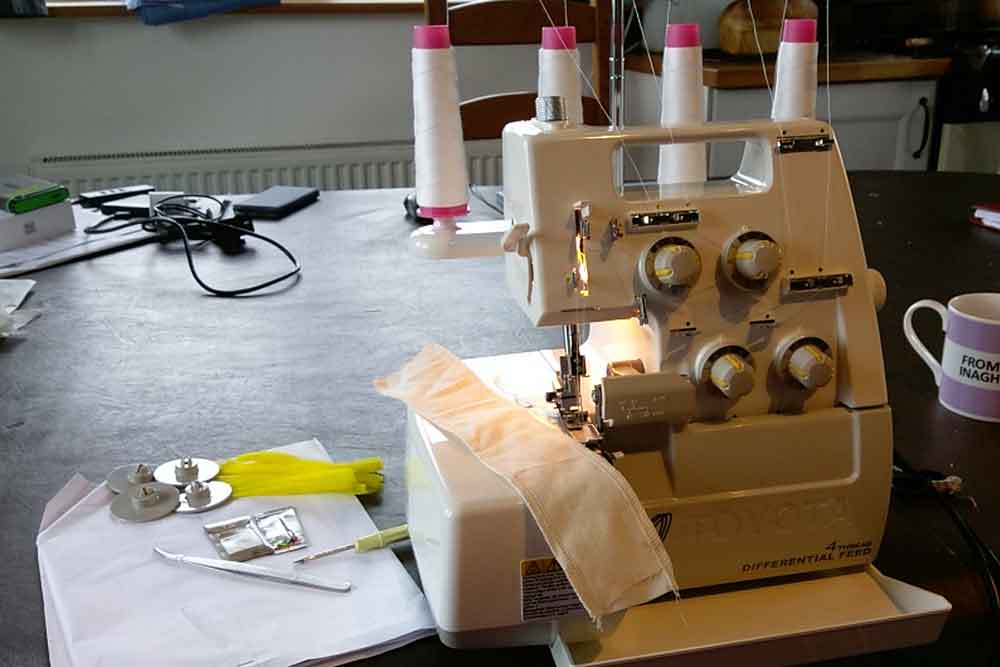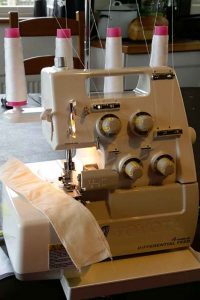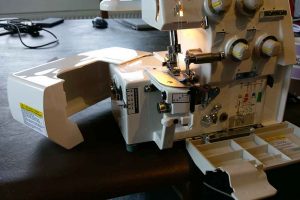
 Goodness knows how, but I carelessly broke one of the guide pins on my trusty Huskylock 905 overlocker, and my backup machine has been left in France, after I was firmly told that there was no room in the car after our summer break. I’m running an overlocker workshop next weekend, and experience has told me that in any class of 4 people, at least one person is likely to have some sort of issue with their machine. Rather than waste valuable class time, I always like to have a spare overlocker on hand just in case we can’t get it going, so I decided to treat myself to a new one.
Goodness knows how, but I carelessly broke one of the guide pins on my trusty Huskylock 905 overlocker, and my backup machine has been left in France, after I was firmly told that there was no room in the car after our summer break. I’m running an overlocker workshop next weekend, and experience has told me that in any class of 4 people, at least one person is likely to have some sort of issue with their machine. Rather than waste valuable class time, I always like to have a spare overlocker on hand just in case we can’t get it going, so I decided to treat myself to a new one.
The machine I chose was a Toyota SL3335 (one of several SL1T-X Series machines), which was reduced from £219.00 to £185, making it not very much more expensive than the Pfaff I bought from Lidl a few years ago. The reviews were good and, though I’ve never had a Toyota sewing machine, I trust the Toyota brand.
Delivery to the Republic of Ireland was stunningly quick from Eastman Staples, via Amazon – ordered on Tuesday, delivered on Friday!
So, straight out of the box, the machine has a pleasingly robust feel to it. It came threaded with four mini cones of fairly poor quality white thread, which immediately broke as I chained off to remove the sample fabric from under the presser foot. Oh, snap! Nevermind, I’ll need to know how to thread the machine anyway, so straight out of the box is as good a time as any.
The threading illustrations in the manual are unhelpfully small and, while the machine appeared to be chaining and cutting, it was not stitching. So often it’s just a seemingly insignificant detail in the threading order that can make all the difference, and this case was no exception. Having had several unsuccessful attempts, I eventually resorted to YouTube and found this excellent tutorial from aisin.fr -a French gentleman, I’d guess, but the video is clear, well-made and silent, so there are no language issues to worry about. Anyway, Monsieur Aisin seems to be a bit of an expert in the field of Toyota sewing machines: https://www.youtube.com/watch?v=vg4Rjnzh4aQ. Contrary to the the user manual – and every other overlocker I’ve ever used – he threads the lower looper first. I’ve no idea what difference this sequence could possibly make, but it worked! Having run a calico sample through the machine several times (to loosen up the new mechanism and distribute any lubrication), the machine produced a nice even stitch. The factory tensions settings were pre-set at 5 (left needle), 3 (right needle), 3 (upper looper) and 3 (lower looper), and I didn’t feel the need to alter them.
 What I particularly like about this machine is the accessibility. To thread the lower looper, you simply swing the left-hand side cover open and turn the hand wheel until the thread guide is visible. This arrangement also makes cleaning the machine a doddle. The mechanism is simple, compared to many, and the parts seem good quality. For such an inexpensive machine, it seems to check all the boxes for functionality too. There’s an adjustment for the presser foot pressure and you can alter the differential, stitch length, and cutting width. There’s even a neat little lever that takes the stitch finger out of the way for a rolled edge.
What I particularly like about this machine is the accessibility. To thread the lower looper, you simply swing the left-hand side cover open and turn the hand wheel until the thread guide is visible. This arrangement also makes cleaning the machine a doddle. The mechanism is simple, compared to many, and the parts seem good quality. For such an inexpensive machine, it seems to check all the boxes for functionality too. There’s an adjustment for the presser foot pressure and you can alter the differential, stitch length, and cutting width. There’s even a neat little lever that takes the stitch finger out of the way for a rolled edge.
At £185, one doesn’t expect too much in the way of accessories. This machine comes with two little packets of good-quality Organ HAX1 (705/130) overlocker needles in sizes 11 and 14, a small flathead screwdriver for changing the needles, a pair of (frankly, rather useless) tweezers, 4 cone nets, and 4 spool adapters. What I liked best was that it came with a waste tray. My Huskylock has a nice little net bag for catching off-cuts, but so many of the more basic machines leave you to find your own solution.
What’s not to like about the Toyota SL3335? Perhaps the only thing that lets it down is the multi-language User Manual. For my middle-aged eyes, the typeface and illustrations are just too small. But that’s a minor gripe. I’ll need to use the machine a bit to fully explore its capabilities, but initial impressions are that it’s a great little machine for the money.




Very Helpful thank you. Could you kindly point me in the direction of suitable needles please as I am about to order one.
Hi Lisa, it’s a great little machine. One of the best things I didn’t mention is that it takes standard sewing machine needles (type 705/130)!
Hi can you just use this machine as a standard sewing machine as I don’t have much overlocking to do and I have this machine not being used
Hi Joan
Was that a gift or an impulse buy, I wonder? The answer to your question is “no” and “yes”. An overlocker serves the particular purpose of sewing, trimming and finishing the edges of your seams. So, no, it doesn’t sew like a normal sewing machine. But it depends on the sewing you are doing. As a dressmaker, I wouldn’t be without my overlocker. There simply is no better way to finish the seams of clothes that are going to be put in the washing machine. There are other ways, of course, but they tend to be either prone to eventual fraying (zig-zag or pinking), or time-consuming (French, fell, edge-stitched, or bound, for instance).
Overlockers are also really useful for sewing stretch and jersey fabrics. T-shirts, pyjamas, and leggings, can be put together in a jiffy, as the differential setting effortlessly copes with the stretch element of the fabric and there’s no need to go back to trim and finish the seams. On the other hand, if you don’t do a lot of dressmaking, I can see that you wouldn’t get much use out of an overlocker.
However, I must add that when I was running my overlocker classes, I found that a lot of students were coming to me with machines that they’d had for years, but they lacked the confidence to use – either because they were afraid of the knife accidentally cutting into their garment, or because they couldn’t re-thread them. Once we had spent an anarchic morning unthreading and re-threading, experimenting with the tension settings and the differential, and generally messing about with pieces of scrap fabric, everyone found themselves capable of putting together a basic t-shirt in a couple of hours, with no need of a conventional sewing machine.
Do you still like this machine? I’m looking to buy one and it’s all a bit of a minefield.
I do like the Toyota. To be fair, I probably wouldn’t have thought of it if it hadn’t have been on sale. It’s a secondary machine for me, as my main workhorse is a much more expensive, and much older, Husqvarna Huskylockk. But I really can’t fault the Toyota for the price. I would say it’s a much more solid and infinitely better built machine than the Singers that you can buy in Lidl and Aldi for around the same price. Easy to thread too, which – if you’re choosing your first machine – can be a real deal-breaker. Only downside is the size of the manual with its miniscule diagrams but, again, I’ve been spoiled with the Husqvarnas. Whatever machine you choose, you’ll probably find a helpful threading video on YouTube.
I really appreciate the threading YouTube for when in the future I have to thread it myself & your from new machine review. Yours was the only Google review I could find.
I’ve always wanted an overlocker & got to use a friend’s years ago but not since.
6 weeks ago I acquired a 2nd hand one for free. Not knowing it’s history, & knowing probably best to have it serviced as I have done with my Jenome sewing machine from new, I spent the money, got it back threaded.
I’m still to turn it on & try it as at the moment I am time poor. Expected rainy days with remedy that.
The only thing they picked up at the servicing is that the tension knobs all read slightly off 0 when tension is set at 0. No master tension with this model to reset all to read 0. I have accepted as thus, taking note & photos, due to more cost. Estimate of work came into $20 less.
As a now 5 year user of this machine are you familiar enough with it to comment if this will be an issue especially as a beginner overlocker?